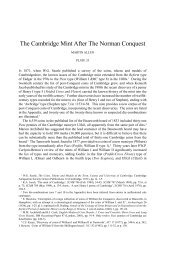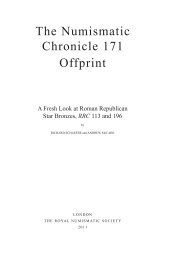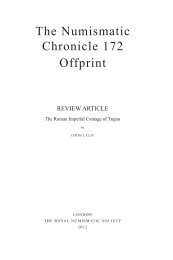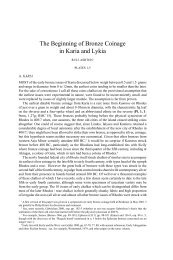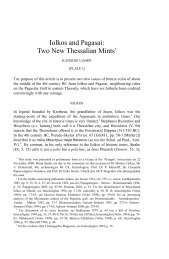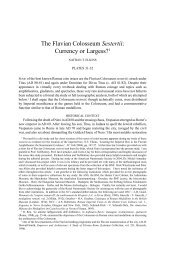The Numismatic Chronicle 171 Offprint - Royal Numismatic Society
The Numismatic Chronicle 171 Offprint - Royal Numismatic Society
The Numismatic Chronicle 171 Offprint - Royal Numismatic Society
You also want an ePaper? Increase the reach of your titles
YUMPU automatically turns print PDFs into web optimized ePapers that Google loves.
THE CONFUCIAN MESSAGE ON VIETNAMESE COINS 379<br />
Inscription found on coins of the Thiệu Trị 79 and Tự Đức 80 eras. <strong>The</strong> reverse illustrated<br />
by Schroeder, no. 165, and attributed to the Minh Mạng era is not genuine.<br />
This expression, taken from <strong>The</strong> Doctrine of the Mean, refers to one of the most<br />
important Confucian virtues, sincerity (Ch. cheng 誠; Viet. thành). 81<br />
16. 壽考萬年 Thọ khảo vạn niên<br />
Ch. Shou kao wan nian // A longevity of ten thousand years.<br />
Inscription found on coins of the Thiệu Trị 82 and Tự Đức 83 eras. <strong>The</strong> reverse illustrated<br />
by Schroeder, no. 166, and attributed to the Minh Mạng era is a coin of the Thiệu<br />
Trị era.<br />
<strong>The</strong>se are the last four characters in the poem Xin Nanshan 信南山 in the Book of<br />
Odes (Shijing), in which a high dignitary evokes the care he takes in agriculture and<br />
in ancestor worship: ‘<strong>The</strong> fi eld boundaries are so fi ne, so fi ne; the grains they are<br />
so good, so good; I am the grandchild with the harvest, making wine and food for<br />
ancestor and guest, a longevity of ten thousand years’ (Jiang tang yiyi, shu ji yuyu ,<br />
ceng sun zhi se yi wei jiu shi, bi wo shi bin, shou kao wan nian 疆場翼翼,黍稷彧<br />
彧,曾孫之穡以為酒食,畀我尸賓,壽考萬年). 84<br />
17. 裕國利民 Dụ quốc lợi dân<br />
Ch. Yu guo li min // Enrich the state, benefi t the people.<br />
Inscription found on coins of the Thiệu Trị85 era. <strong>The</strong> reverse illustrated by Schroeder,<br />
no. 167, and attributed to the Minh Mạng era is a coin of the Thiệu Trị era.<br />
This is a variant of the phrase ‘make the country rich, benefi t the people’ (fu guo li<br />
min 富國利民) found in Chapter 8 of Wenzi 文子. It encapsulates the meaning of the<br />
full quote: ‘<strong>The</strong> ancient kings chose their time well and used it wisely, that is the way<br />
to enrich the state and benefi t the people’ (xian wang zhi suoyi ying shi xiubei, fu guo<br />
li min zhi dao ye 先王之所以應時脩備,富國利民之道也). 86<br />
79 AS, III, p. 18; CMVS, no. 422.<br />
80 Barker, Historical cash coins of Viêt Nam, no. 199.<br />
81 Zhongyong, XXVI, p. 56. Legge, (Four Books, p. 405) translates this as ‘So far-reaching and long-<br />
continuing, it makes him infi nite.’<br />
82 Schroeder, Annam. Etudes numismatiques, no. 218, CMV, no. 1602; Barker, Historical cash coins<br />
of Viêt Nam, no. 177.<br />
83 Lacroix, Numismatique annamite, no. 471; Barker, Historical cash coins of Viêt Nam, no. 195.<br />
84 Shijing, Xiaoya-VI-6, p. 281. Waley (Book of Songs, p. 212, no. 200) translates this as ‘<strong>The</strong><br />
boundaries and balks are strictly drawn;/<strong>The</strong> wine-millet and cooking-millet give good yield,/To be<br />
harvested by the descendant;/That he may have wine and food/To supply the Dead One and the guests,/<br />
And so get life long-lasting.’<br />
85 Lacroix, Numismatique annamite, no. 455; CMV, no. 1606.<br />
86 Wenzi, Shangren-X, Chinese Text Project. <strong>The</strong> Wenzi was a Taoist work, long considered a later<br />
fake, until a version written on bamboo slips (the old Wenzi) was discovered in 1973 in the tomb of<br />
Prince Huai of Zhongshan (55 BC); the old Wenzi was perceptibly different from the canonical Wenzi<br />
(the modern Wenzi) which seems to have been compiled from the original text and from passages taken<br />
from other ancient works, in particular the Huainanzi (c.139 BC), see Le Blanc, pp. x–xii, 8–9.



